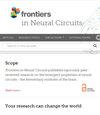从耳蜗核到外侧上橄榄的抑制性甘氨酸能投射
IF 3.4
3区 医学
Q2 NEUROSCIENCES
引用次数: 0
摘要
侧上橄榄(LSO)的听脑干神经元接受来自同侧耳蜗核(CN)的兴奋性输入,并通过梯形体内侧核(MNTB)接受来自对侧耳蜗核的抑制性传递。这个电路可以利用耳间声级差进行声音定位。早期的研究已经观察到来自同侧的额外抑制输入。然而,它的许多细节,比如它的起源,仍然难以捉摸。通过对急性小鼠脑干切片的传入事件进行电和光刺激和解剖追踪,我们在这里描述了源自同侧CN的LSO主神经元的甘氨酸能投射。这种抑制性突触输入可能介导LSO神经元对声刺激的抑制性侧带。本文章由计算机程序翻译,如有差异,请以英文原文为准。
An inhibitory glycinergic projection from the cochlear nucleus to the lateral superior olive
Auditory brainstem neurons in the lateral superior olive (LSO) receive excitatory input from the ipsilateral cochlear nucleus (CN) and inhibitory transmission from the contralateral CN via the medial nucleus of the trapezoid body (MNTB). This circuit enables sound localization using interaural level differences. Early studies have observed an additional inhibitory input originating from the ipsilateral side. However, many of its details, such as its origin, remained elusive. Employing electrical and optical stimulation of afferents in acute mouse brainstem slices and anatomical tracing, we here describe a glycinergic projection to LSO principal neurons that originates from the ipsilateral CN. This inhibitory synaptic input likely mediates inhibitory sidebands of LSO neurons in response to acoustic stimulation.
求助全文
通过发布文献求助,成功后即可免费获取论文全文。
去求助
来源期刊

Frontiers in Neural Circuits
NEUROSCIENCES-
CiteScore
6.00
自引率
5.70%
发文量
135
审稿时长
4-8 weeks
期刊介绍:
Frontiers in Neural Circuits publishes rigorously peer-reviewed research on the emergent properties of neural circuits - the elementary modules of the brain. Specialty Chief Editors Takao K. Hensch and Edward Ruthazer at Harvard University and McGill University respectively, are supported by an outstanding Editorial Board of international experts. This multidisciplinary open-access journal is at the forefront of disseminating and communicating scientific knowledge and impactful discoveries to researchers, academics and the public worldwide.
Frontiers in Neural Circuits launched in 2011 with great success and remains a "central watering hole" for research in neural circuits, serving the community worldwide to share data, ideas and inspiration. Articles revealing the anatomy, physiology, development or function of any neural circuitry in any species (from sponges to humans) are welcome. Our common thread seeks the computational strategies used by different circuits to link their structure with function (perceptual, motor, or internal), the general rules by which they operate, and how their particular designs lead to the emergence of complex properties and behaviors. Submissions focused on synaptic, cellular and connectivity principles in neural microcircuits using multidisciplinary approaches, especially newer molecular, developmental and genetic tools, are encouraged. Studies with an evolutionary perspective to better understand how circuit design and capabilities evolved to produce progressively more complex properties and behaviors are especially welcome. The journal is further interested in research revealing how plasticity shapes the structural and functional architecture of neural circuits.
 求助内容:
求助内容: 应助结果提醒方式:
应助结果提醒方式:


